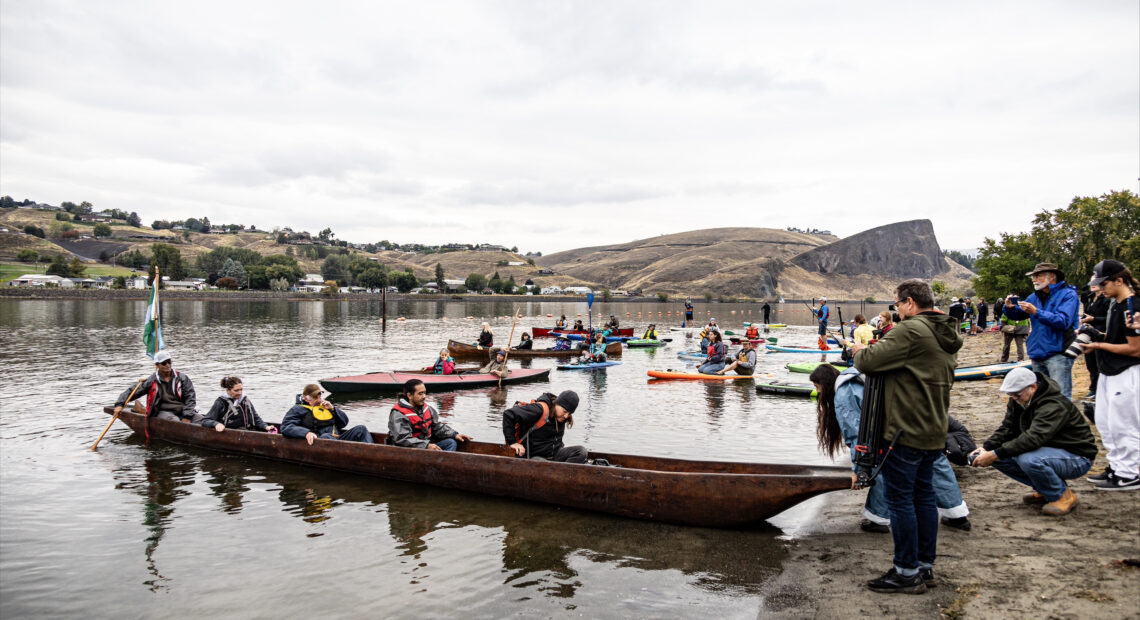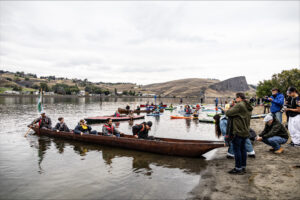
For Nez Perce, Fight for Salmon Extends for Generations
By Sophia Flippin/Murrow News Service
NEZ PERCE, IDAHO _ Government snipers lined the hills above Idaho’s Rapid River. It was the summer of 1980, just five years after the last Lower Snake River dam opened.
The snipers were called in response to Nez Perce families fishing for salmon within the Nez Perce National Forest. Armed Nez Perce veterans spotted the officers and prepared to fight back. No shots were fired that day, but it represented a key moment in the fight by the Nez Perce to uphold fishing rights, even as salmon run numbers have declined.
“When the salmon disappear, then our life starts disappearing, everything that we stand for, that we do,” said Silas Whitman, a Nez Perce elder with decades of experience working within tribal fisheries and tribal treaty resource management. “That’s why it’s so important.”
Last fall, President Biden signed a Presidential Memorandum to prioritize restoring wild salmon and steelhead into the Columbia River Basin and pledging support to tribal conservation efforts. Without intervention, federal scientists predict Pacific Northwest salmon and steelhead will be extinct within the next 40 years. But a key step — removing dams along the rivers — could threaten an important energy source in the Pacific Northwest.
Today, nearly half of the spring and summer Chinook salmon populations in the Snake River Basin are seeing fewer than 50 fish return, said Henry Roller, a member of the Snake River Savers, a grassroots volunteer organization that advocates for breaching the four Lower Snake River dams.
“It is plain and simple close to extinction,” Roller said.
For tribe, a sacred species
If the salmon and steelhead go extinct, an ancient aspect of the Nez Perce Tribe’s culture will die with them. In the Nez Perce creation story, salmon volunteered their meat and spirit to ensure the Nimiipuu’s survival, Whitman explained. The tale ends with the salmon and the other animals becoming mute upon the Nimiipuu’s arrival. The Nimiipuu have since pledged to be their voice.
“They call us The Salmon People,” Whitman said.
Each distinct species of salmon signifies a change in the environment and guides the Nez Perce in conducting hunts, accessing different foods, and performing ceremonies, he said.
Environmental experts argue that breaching the Lower Snake River dams is the only way to save the salmon population and the surrounding ecosystem, said Kate Comer, a Portland State University rhetoric professor and DamSense activist. DamSense is a volunteer coalition advocating for breaching the dams to save salmon and orcas while honoring tribal treaties.
“The rivers are the lifeblood of the land. They are what make nature work,” Comer said.
Salmon are a keystone species, meaning other animals in the ecosystem depend on them for survival, Larkin said. Nearly 140 species in the region rely on PNW salmon, she said. For example, if the salmon die out, the critically endangered pod of 75 Southern Resident killer whales in Puget Sound will starve and follow suit, Comer said. Wolves, bears, and lampreys, another fish sacred to many PNW tribes, will starve. Insects will go largely uneaten by fish and bug populations will explode, she said.
Four hydroelectric U.S. Army Corps of Engineers dams across southeastern Washington’s Lower Snake River are likely at fault, according to a 2022 National Marine Fisheries Service report. In the early 20th century, hundreds of thousands of wild salmon returned to Pacific Northwest spawning grounds each year. Just 10 years after the dams’ construction, not a single coho salmon could be found along Idaho’s Clearwater Basin.
Idaho banned salmon fishing during the summers of 1979 and 1980 after seeing startling low salmon returns at Rapid River Hatchery in central Idaho. The hatchery was built to offset the damage the Snake River dams have on the salmon population.

Photo by Cole Quinn. Snake River Dam Campaign supporters prepare to launch canoes into the Snake River to advocate for the removal of multiple nearby dams, Sept. 30, 2023, at Hells Gate State Park in Lewiston, Idaho.
The Nimiipuu saw the ban as an infringement upon their treaty rights, especially since tribal leaders had already restricted fishing to weekends and limited how many fish one could harvest. Historically, a Nimiipuu adult used to eat one pound of salmon each day, on average. Now one would be lucky to get one fish per year, said Mitch Cutter, Idaho Conservation League salmon and steelhead associate.
“That would be a good year for many of these groups,” Cutter said. “A really good year, actually.”
Historic rights but dwindling number of fish
In 1855, the federal government guaranteed the Nimiipuu the right to fish within a 13.4 million acre area in addition to their “usual and accustomed places.” The U.S. government promised these fishing rights when the Nimiipuu ceded 7.5 million acres of tribal land, according to the treaty.
Many of these “accustomed places” have been destroyed due to dam construction, Cutter said. Fishing is no longer a right if there are none to catch, he added.
The Lower Snake River dams have been impeding the journey of salmon to and from the Pacific Ocean since their construction in the 1960s and 70s, according to the National Marine Fisheries Service report. Juvenile salmon swim hundreds of miles downriver to reach the Pacific Ocean. They will mature for a couple of years before swimming back upstream to their native freshwater rivers to spawn eggs of their own, said Christopher Caudill, associate professor of fisheries at the University of Idaho. Less than 1% of salmon passing through the Snake River return home, experts say.
The journey from the salmon’s home tributaries goes smoothly until they reach the first of the four Lower Snake River dams—the Lower Granite. The fish have three options to pass through each dam. Some funnel through a narrow pipe that leads to the other side of the dam, called the juvenile bypass system, and risk being eaten by the birds and larger fish who have learned to wait by the bypass’s deposit, Cutter explained. Other salmon attempt to swim through the 20-foot-long dam turbines, but this is often grisly. Lastly, the fish can opt to go over the top of the dam through the spillway like a waterfall, he said.
“You can imagine what a 100-foot drop does to a six-inch salmon. The results are not that pretty,” Cutter said.
Dams cause the water to go stagnant. This leads to water temperatures rising to 71 to 72 degrees, said Lucy Larkin, a Snake River Savers member. The fish can bear temperatures up to 68 degrees, she said.
Lethal temperatures like these lead to a combination of cardiac arrest and insufficient oxygen. Temperatures slightly above 68 degrees can weaken a fish’s immune system and increase their metabolism until they become catatonic and die, Caudill said.
Increasing water temperatures in the Eastern Pacific Ocean due to rising greenhouse gasses exacerbate the problem, experts say.
Activist groups and the Nez Perce Tribe continue to advocate for the Lower Snake River dams to be breached to save the salmon from extinction.
“Salmon keep everything in balance, and we are living in a time where we are watching what happens when nature is out of balance,” Comer said. “What that means is devastation and unsustainable livability in the Pacific Northwest.”















